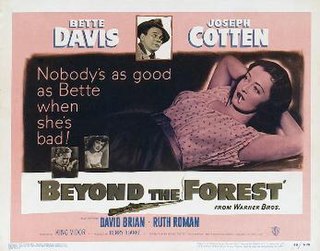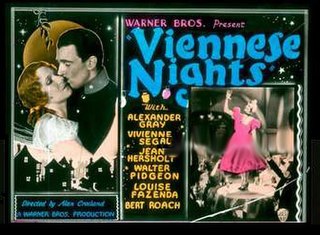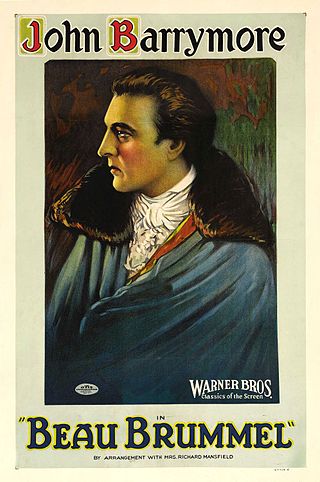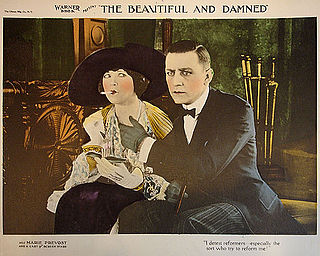
The Smiling Lieutenant is a 1931 American pre-Code musical comedy film directed by Ernst Lubitsch, starring Maurice Chevalier, Claudette Colbert and Miriam Hopkins, and released by Paramount Pictures.

Marie Prevost was a Canadian-born film actress. During her 20-year career, she made 121 silent and sound films.

Beyond the Forest is a 1949 American film noir directed by King Vidor, and featuring Bette Davis, Joseph Cotten, David Brian, and Ruth Roman. The screenplay is written by Lenore Coffee based on a novel by Stuart Engstrand.

Sonny Boy is a 1929 sound part-talkie film released by Warner Bros., directed by Archie Mayo. In addition to sequences with audible dialogue or talking sequences, the film features a synchronized musical score and sound effects along with English intertitles. The soundtrack was recorded using the Vitaphone sound-on-disc system. The film stars Davey Lee, Edward Everett Horton, and Betty Bronson.

Florence Vidor was an American silent film actress.

Viennese Nights is a 1930 American all-talking pre-Code musical operetta film directed by Alan Crosland and starring Alexander Gray, Vivienne Segal, Walter Pidgeon, Jean Hersholt, Bela Lugosi and Louise Fazenda. It was photographed entirely in Technicolor and released by Warner Brothers. Viennese Nights was the first original operetta written especially for the screen by Oscar Hammerstein II and Sigmund Romberg. It was filmed in March and April 1930, before anyone realized the extent of the economic hardships that would arrive with the Great Depression, which had begun in the autumn of the previous year. Although not a box office hit in the United States, the film had long box office runs in Britain and Australia. It is one of the earliest sound films to have a short pre-credit sequence.

The Oyster Princess is a 1919 German silent comedy film directed by Ernst Lubitsch and starring Victor Janson, Ossi Oswalda and Harry Liedtke. It is a grotesque comedy in four acts about an American millionaire's spoiled daughter's marriage that does not go as planned. It was shot at the Tempelhof Studios in Berlin. The film's sets were designed by the art director Kurt Richter, a frequent collaborator of Lubitsch.

Three Women, also known as Die Frau, die Freundin und die Dirne, is a 1924 American silent drama film starring May McAvoy, Pauline Frederick, and Marie Prevost, directed by Ernst Lubitsch, and based on the novel Lillis Ehe by Yolande Maree.

Beau Brummel is a 1924 American silent historical drama film starring John Barrymore and Mary Astor. The film was directed by Harry Beaumont and based upon Clyde Fitch's 1890 play, which had been performed by Richard Mansfield, and depicts the life of the British Regency dandy Beau Brummell.

Lady Windermere's Fan is a 1925 American silent drama film directed by Ernst Lubitsch. It is based on Oscar Wilde's 1892 play Lady Windermere's Fan which was first played in America by Julia Arthur as Lady Windermere and Maurice Barrymore as Lord Darlington. The film is being preserved by several archives. It was transferred onto 16mm film by Associated Artists Productions in the 1950s and shown on television. In 2002, Lady Windermere's Fan was selected for preservation in the United States National Film Registry by the Library of Congress, being deemed "culturally, historically, or aesthetically significant."

The Beautiful and Damned is a 1922 American silent drama film directed by William A. Seiter and released by Warner Bros. The film, based on F. Scott Fitzgerald's 1922 novel The Beautiful and Damned, starred Kenneth Harlan and Marie Prevost.

Kiss Me Again is a 1925 American silent romantic comedy film directed by Ernst Lubitsch. It stars Marie Prevost, Monte Blue, and Clara Bow. The film was based on the French play Divorçons! (1880), by Victorien Sardou and Émile de Najac, and the adapted version of the play Cyprienne.

Main Street is a 1923 American silent drama film based on the 1920 novel of the same name by Sinclair Lewis. It was produced and distributed by Warner Bros. and directed by Harry Beaumont. A Broadway play version of the novel was produced in 1921. It was the first film to be released after the foundation of Warner Bros. Pictures on April 4, 1923.

The Flirting Widow is a 1930 American pre-Code comedy film directed by William A. Seiter and starring Dorothy Mackaill, Basil Rathbone, Leila Hyams and Claude Gillingwater. It was produced and released by First National Pictures, a subsidiary of Warner Bros.

So This Is Paris is a 1926 American silent comedy film produced and distributed by Warner Bros. and directed by Ernst Lubitsch. It is based on the 1872 stage play Le Reveillon by Henri Meilhac and Ludovic Halévy. It stars Monte Blue and Patsy Ruth Miller. The film is preserved in many archival holdings including the Library of Congress and the Turner Entertainment Company.

Albert Paulig was a German film actor who was popular during the silent era. Paulig made his first film in 1914. The following year he appeared in one of Ernst Lubitsch's first directorial attempts, A Trip on the Ice (1915). Paulig was in a number of Harry Piel, thrillers including The Man Without Nerves (1924).

The Man Upstairs is a 1926 American silent comedy film directed by Roy Del Ruth and starring Monte Blue. It was produced and distributed by Warner Brothers. The film is based on the 1916 novel The Agony Column by Earl Derr Biggers.
Her Marriage Vow is a 1924 American drama film written and directed by Millard Webb. The film stars Monte Blue, Willard Louis, Beverly Bayne, Margaret Livingston, John Roche and Priscilla Moran. The film was released by Warner Bros. on July 20, 1924.

The Dark Swan is a 1924 American drama film directed by Millard Webb and written by Frederick J. Jackson. It is based on the 1924 novel The Dark Swan by Ernest Pascal. The film stars Marie Prevost, Monte Blue, Helene Chadwick, John Patrick, Lilyan Tashman, and Vera Lewis. The film was released by Warner Bros. on November 26, 1924.

Christine of the Hungry Heart is a 1924 American silent drama film directed by George Archainbaud and starring Florence Vidor. It was produced by Thomas H. Ince and released through First National Pictures.



















